The Bat-signal: The first season of Batman was the hottest thing since sliced bread, and prompted both a feature film and half of Hollywood wanting to get in on the fun. However, as the second season plodded onward, the novelty had worn off and the audience had moved on to other things. Folks like Vincent Price and Otto Preminger and the like all came in to jump on the bandwagon, but by the time they arrived, the wagon had left town.
By the third season, the producers at once took steps to try to shore up what audience remained, yet also made it clear that they had stopped giving a horse’s patoot. The former was addressed by adding Yvonne Craig’s Batgirl to the main cast; the latter, sadly, sabotaged Craig’s presence, as the budget was razed, presenting a show that was very obviously being done on the cheap and by producers who had stopped caring.
However, the show’s influence and staying power was impressive. Like that other show I’m rewatching, the show continued to have a powerful life in syndicated reruns. (That was how your humble rewatcher first encountered it.) For decades afterward, Batman ‘66 was everyone’s touchstone for how to talk about comics, specifically the iconic sound effects used when fisticuffs ensued. (Pretty much every article about how “comics aren’t for kids anymore” written between 1980 and 2000 used “Pow! Zap!” or some such in the article’s title. It grew tiresome.)
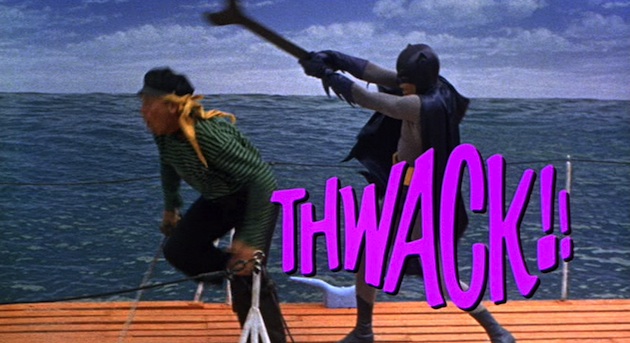
Adam West and Burt Ward suffered considerable typecasting, as they became inextricably linked with the iconic roles. They would find themselves in the following decade returning to those roles twice.
The first time was on The New Adventures of Batman, a 16-episode Filmation-produced series. The stories were all run-of-the-mill bad guy stuff that was straight out of the Silver Age comics—and other Saturday morning cartoons of the era. They even had a doofy sidekick in the interdimensional imp Bat-Mite, a powerful-yet-dim creature who kept trying to help and making things worse. Batgirl was also present, though veteran voiceover actor Melendy Britt voiced her rather than Craig. Britt in fact did all the female voices, with most of the other male voices being provided by Filmation vet Lennie Weinrib, including almost all the male villains. Each was given some kind of vocal tick to differentiate them, the most extreme being Professor Bubbles who sounded like Mush Mouth from Fat Albert. (The one exception was Boyd Baxter, a TV newscaster voiced by Larry Storch.) Producer Lou Scheimer provided the voices of Bat-Mite and the Bat-computer.
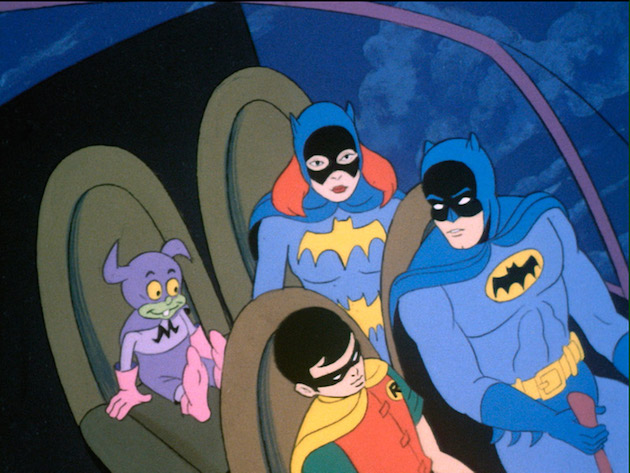
Each episode followed a standard formula, with the villain plotting to take over Gotham or the world or whatever, and our heroes stopping them, even with Bat-Mite slowing them down with his idiocy. The show was a mix of elements from the TV series (Robin’s copious use of “Holy ____!” as well as the spectacular incompetence of Gordon and the GCPD) and the comics (the design of the Batcave is closer to the comics, and Batman fights super-powered beings and aliens and such). The design is an interesting mix of Dick Sprang and Neal Adams, and of course Batman and Robin are far more athletic here than they are in live-action. We get some new bat-gadgets, most notably the seats of the Batmobile that eject and become autogyros, and now the Bat-computer talks—and has something of an attitude, too.
And, this being Filmation, they ended each episode with a “Bat-message,” with Batman and Robin delivering the moral of the story while Bat-Mite does something wacky and annoying.
This was hardly the first foray of Batman and Robin in animation—they were part of the Batman/Superman Hour, which was contemporary with the TV series, with Olan Soule and Casey Kasem voicing Batman and Robin, respectively. Soule and Kasem would reprise the roles on the various Super Friends cartoons, though Soule was later replaced by West as Batman, with Kasem continuing as Robin. (Soule’s consolation was to do the voice of Martin Stein, half of Firestorm.)
West and Ward also stepped in front of the camera to reprise their roles as Batman and Robin for the ill-advised 1979 specials Legends of the Super Heroes, an appalling mix of superhero story and variety show that didn’t work on any possible level. Both West and Ward were phoning it in—and looked even more ridiculous in the outfits a decade later. Ed McMahon hosted and actually did the best he could—he at least faked taking it seriously—but the shows fall into the same what-the-hell-were-they-smoking-in-the-1970s-anyhow category as The Star Wars Holiday Special.
And of course, West and Ward got back into the Bat-game in 2016 for the 50th anniversary in The Return of the Caped Crusaders, as well as its upcoming sequel…
Favorite Fetch the Bat-shark-repellant! I think my favorite Bat-device still has to be the Bat-shield, just because it’s so unutterably ridiculous.
Favorite Holy #@!%$, Batman! I gotta say that after a year and a half of chronicling them, the vast majority of Robin’s religious utterances leave me cold, and it could get pretty ridiculous. Still, I liked it when it looked like some thought went into it, like “Holy Wernher von Braun!” in “The Greatest Mother of Them All” / “Ma Parker” and the cleverer ones in the film like “Holy Bikini” and “Holy Polaris.”
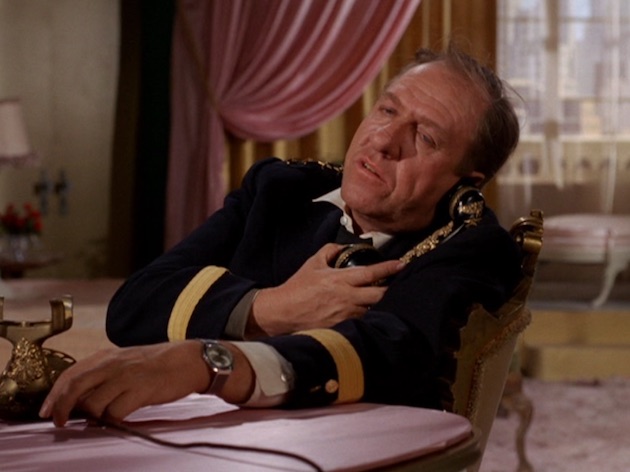
Favorite Gotham City’s finest. A tie between “The Sandman Cometh” / “The Catwoman Goeth“—where Mooney, Hogan, and Dietrich, are actually competent and skilled and stuff—and “The Joker Goes to School” / “He Meets His Match, the Grisly Ghoul” where the cops (aided by a convenient blackout) are actually the ones who rescue Batman and Robin from that week’s deathtrap.
Favorite No sex, please, we’re superheroes. Definitely “King Tut’s Coup” / “Batman’s Waterloo,” where “milk and cookies” is the best euphemism ever!
Favorite Special Guest Villain. With all due respect to Burgess Meredith, Julie Newmar, and Cesar Romero, who justifiably became icons, and equal respect to Anne Baxter, Victor Buono, Eartha Kitt, Roddy McDowall, Vincent Price, and Cliff Robertson, who were all magnificent, the best villain in the Bat-pantheon has to be Frank Gorshin, who simply owned the character of the Riddler. The others all had aspects that worked—Gorshin, though, fired on all cylinders, creating a complex, layered villain with scripts that didn’t actually require that. Amazing stuff.
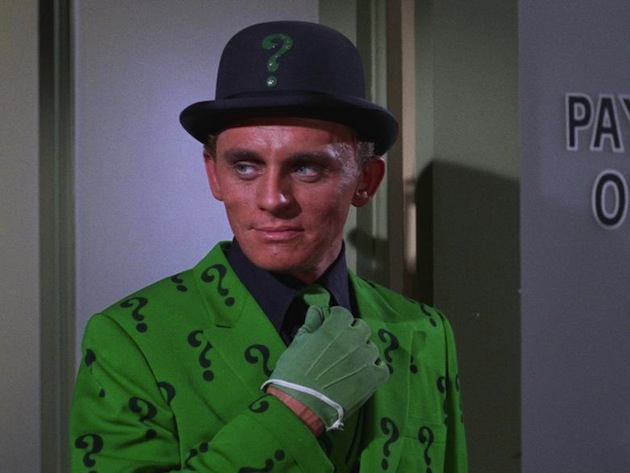
Favorite Na-na na-na na-na na-na na. So many great lines, but this one from “The Unkindest Tut of All” remains my favorite, as it’s hilarious Bat-alliteration followed by a line Buono was born to read:
“Come off it, Tut. Your predictions are nothing but phony fatuous flimflam.”
“Who dares impugn the veracity of Tut—nabob of the Nile, moon god of Thoth, and stuff like that? By the instep of Ramses, I’ll have his head!”
Favorite Trivial matters: Probably the one for “A Piece of the Action” / “Batman’s Satisfaction,” as it had lots of Green Hornet-y goodness.
Pow! Biff! Zowie! “Same bat-time, same bat-channel!” And so we come to the end of the Bat-rewatch. It’s a show that tapped into the zeitgeist of the time in which it was created, melding Silver Age goofiness with Pop Art zaniness and a technicolor palette to give us a perfect storm of campy hilarity.
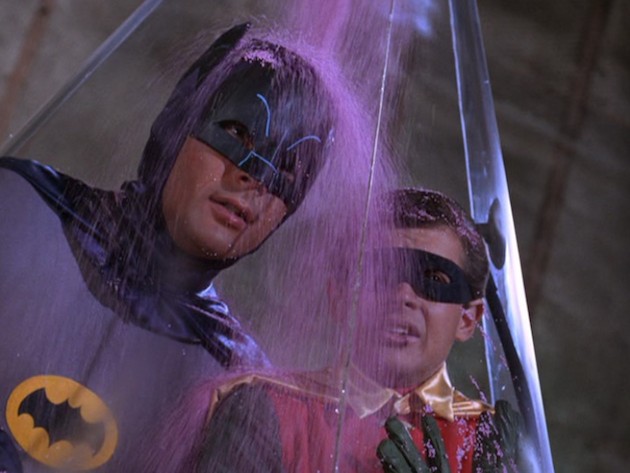
Still, the show was in many ways a victim of its success. By becoming the it-show, as it were, the producers became more self-conscious and emphasized the goofier aspects, as well as the cameos and guest appearances. So many comedians making uncredited cameos, so many celebrities opening the window on a bat-climb, so many actors showing up as villains, not always to good effect (yes, Art Carney and Van Johnson, I’m looking at you).
Yet the show continued to thrive long after it was cancelled. It even had a kind of reverse-positive effect on the comics, as backlash against the overwhelming silliness of the TV show—which had been the norm in the Batman comics pretty much since the Comics Code Authority defanged mainstream comics in the 1950s—led to the character becoming darker and more serious in the 1970s, closer to the more hard-bitten character originally portrayed by Bill Finger and Bob Kane.
Ultimately, though, the show itself was tremendous fun to watch. At its best, it was a vehicle for brilliant satire (“Hizzoner the Penguin” / “Dizzoner the Penguin,” “Pop Goes the Joker” / “Flop Goes the Joker“) and high comedy (“Death in Slow Motion” / “The Riddler’s False Notion,” “An Egg Grows in Gotham” / “The Yegg Foes in Gotham“). And even at its worst, it gave us a weekly dose of the triumph of good over evil, which is never a bad thing to see on your television screen.
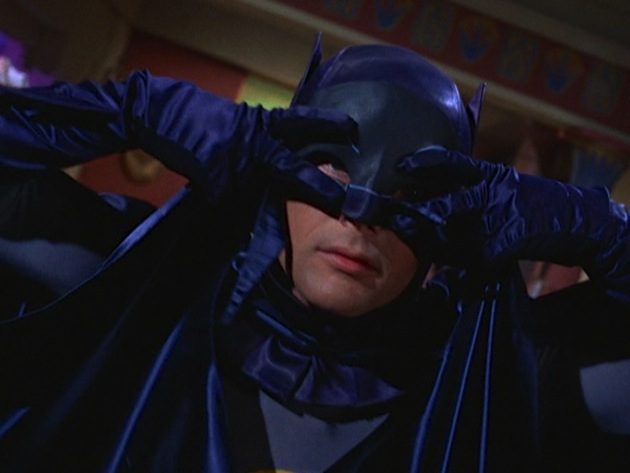
Bat-rating: 7
Keith R.A. DeCandido will miss doing this every week, but won’t miss tallying up all Robin’s “Holy” utterances. Be on the lookout for his overview of the 1970s Wonder Woman TV show some time between now and the release of the Gal Gadot film.










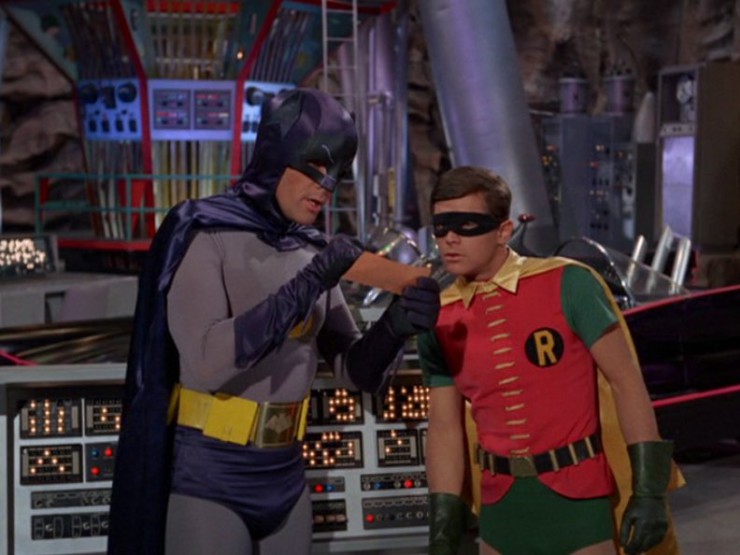
Thanks for all of the reviews! I admit I’m sad it has come to an end; while I love all of your reviews, these always gave me something to look forward to. And while i agree with the best Bat-device being the Bat-shield, I will always have a soft spot for the Bat-zooka…
Wow. I’d been thinking about tracking down Legends of the Superheroes for a rewatch, but I couldn’t find the whole thing online. But I think that’s just as well, since I couldn’t even get all the way through that brief clip up above. Not only was it terribly unfunny, but what was with Batman’s cowl being put on wrong? The cape was supposed to fasten over the neckpiece, not under it.
I reveiwed The New Adventures of Batman on my blog in this post, which also covers the second of the two Super Powers Team (Superfriends) seasons that Adam West did. Some excerpts of my thoughts:
While the tone of the show is not quite as campy and satirical as the ’60s live-action sitcom, it’s set in a similar world and influenced by it in a lot of ways, for instance including Batpoles and a Batphone (although for some reason the Batphone in the Batcave is an antique phone hidden in the lid of a barrel) and Robin saying “Holy (something)” every thirty seconds (along with other interjections like “Leaping lumbago!”). But there’s no Alfred or Aunt Harriet, and Barbara is the assistant DA in this version, although that never serves any story purpose beyond giving her an excuse to be standing around in the Commissioner’s office. Batman and Robin are aware of Batgirl’s secret identity in this show, though one episode suggested the reverse was not true.
Adam West’s return to the role of Batman after eight years works pretty well. He doesn’t play it as broadly as he did in the original, except in occasional moments, but it feels like it’s largely the same characterization, and West’s performance is more expressive and convincing than a lot of ’70s cartoon voiceover work. In a couple of early episodes, West even brings back his practice of giving Bruce Wayne a more laid-back, soft-spoken delivery than the more intense Batman, though it’s inconsistent. Ward, meanwhile, is simply terrible. He delivers almost every line in the same labored tone. It’s like he’s trying to recapture the intensity of his original performance, but isn’t able to muster up the same energy or even talk as fast because he’s reading from a script. Between that and the way his voice changed in the intervening years, it occurred to me that it might’ve worked better if they’d sped up the tape a bit. The other performers are simply workmanlike, though Weinrib’s pretty good at doing a wide range of voices, and Britt’s Catwoman has a bit of a Julie Newmar quality that’s nice to hear.
Like most Filmation shows, TNAoB had a brief tag at the end with the heroes talking to the audience — actually called “Bat-Message” segments in this case. This was usually done to convey the moral of the story to the viewers, but TNAoB’s tags only conveyed morals in the first few episodes; for most of the series, they were just rather pointless jokes involving Bat-Mite.
One thing I didn’t mention on my blog is that the ’77 show’s Bat-Mite was the prototype for He-Man‘s Orko 6 years later. They’re essentially the exact same character — a well-intentioned but bumbling magic-user from another dimension (in fact, Bat-Mite’s dimension was called Ergo in the show), child-sized and hovering in midair. And Lou Scheimer played them both with pretty much exactly the same voice.
I haven’t watched TNAoB in decades but having Barbara as assistant DA is a good rationale for her being Police Commissioner in Batman Beyond (beyond the fact that Daddy was Police Commissioner).
Oh, one other West/Ward project of note: Return to the Batcave: The Misadventures of Adam and Burt, a 2003 docudrama special that was part of the trend of nostalgic specials that dramatized the making of classic TV shows. West, Ward, Frank Gorshin, and Julie Newmar appeared as themselves, reminiscing on the making of the show, and their reminiscences were dramatized by other actors. Jack Brewer played the young Adam West, and the young Burt Ward, interestingly, was played by Jason Marsden, an actor who’s done a bunch of superhero-related voice roles including Gear on Static Shock, Snapper Carr on Justice League Unlimited, and Impulse on Young Justice. That was the first of two times that Marsden played a version of Robin, since he also voiced the character in the “Scooby-Doo Movies” segment of Batman: The Brave and the Bold‘s “Bat-Mite Presents: Batman’s Strangest Cases!” He’s also played both young Clark Kent (in Superman: TAS) and young Bruce Wayne (in Beware the Batman), making him the only actor who’s professionally played Superman, Batman, and Robin.
Honestly, even though Marsden was playing Burt Ward playing Robin, I felt he made a more convincing Robin than Ward did.
I was seven years old in 1979, and an unabashed fan of all things superheroic, including Batman ’66, then showing in reruns. Even that version of me thought that Legends of the Superheroes was embarrassingly stupid.
I encountered a guy on Facebook who is quite offended by the existence of the 1960s Batman series. He seems to think it was what clueless TV execs thought a *serious* comic book show would be. He’s quite angry about it, too. The joke is lost on some, I guess.
So was Boyd Baxter possibly a reference to the character Ted Baxter on the Mary Tyler Moore show?
For fans of this series, I have to recommend the very recent “Batman ’66 Meets Wonder Woman ’77” comic. It’s funny in all the right ways and, without spoiling anything, the flash-forward to see what the Adam West-Batverse looks like in the late 70s is worth it to see where (by this narrative) all of the characters end up. A great read.
When I develop a time machine … well, there’s a lot of other things I’ll use it for first, but somewhere on the list is going back to the 1970s and clubbing to death all of those irritating “comedy relief” cartoon sidekicks before their first appearances.
I’m sure I’m not the first to suggest this, but how about a one or two article overview of the Batman ’66 comics and graphic novels? I’d particularly recommend the Green Hornet and Man From U.N.C.L.E. crossovers, both of which manage to be more true to their respective sources than the B66/GH episodes ever did.
@2: Really, though, aren’t Bat-Mite and Orko BOTH at least spiritual descendants of the Great Gazoo, if not outright copies?
@11/critter42: Bat-Mite debuted in the comics in 1959, six and a half years before Gazoo debuted on television. He was a knockoff of the Superman foe Mr. Mxyzptlk (hailing from the same 5th-dimensional race as Mxy, as did the Aquaman version, Quisp, who debuted in 1962), who’d been introduced (as Mr. Mxyztplk) in 1944, and was probably inspired by Rumpelstiltskin and similar imps from folklore.
Gazoo was more of a cross between Aladdin’s genie and the “little green man from space” trope that was popular in the ’50s and ’60s. It’s not out of the question that Gazoo might have had some slight influence on how Filmation adapted Bat-Mite to the screen in 1977 (after all, their Bat-Mite had green skin), but Gazoo is still a latter-day version of the “magical imp” trope.
Anyway, my point is that Orko is not just a spiritual descendant of the ’77 Bat-Mite, but essentially Filmation reusing the same character (and literally the same character voice by Scheimer) in a new context. Similar to how Teela was a reuse of the Princess Aura character design from Filmation’s Flash Gordon with a changed hairstyle and more clothes, and Skeletor’s voice was a reuse of Alan Oppenheimer’s Ming the Merciless voice. A lot about He-Man was recycled from earlier Filmation works, especially Blackstar from just two years earlier.
News articles about comics to this day (I just saw one days ago) keep getting headlined with “POW! ZAP! BIFF!”, and while the show had a positive “seriosfying” effect on the Batman comics, it had the complete opposite on popular culture. People have for decades, and continue to, equate superhero fiction with this show, missing the point that it was a parody.
Still, you gotta love it. Thanks for the rewatch, krad.
@13/MaGnUs: It’s not so much that it was a parody; as we’ve seen over the course of this rewatch, it was in many ways a strikingly faithful adaptation of the way Batman comics had been done over the previous two decades, whereas in other ways it was downright sedate compared to some of the insanity you’d find in Silver Age comics. It’s more that comics evolved out of that mode in the ’70s and ’80s, but popular culture was slow to catch onto that evolution. Generally the mass-media adaptations lagged well behind the comics. The Tim Burton Batman in ’89ff was a strange blend of very, very early 1939 gritty-vigilante Batman, the camp of the ’60s show, and Burton’s own macabre weirdness; we didn’t see a live-action Batman movie that resembled the Batman comics of the ’80s and ’90s until Christopher Nolan came along in 2005. Even Batman: The Animated Series in the ’90s was a distillation of the preceding two decades of Batman comics storytelling, weighted more toward the ’70s comics than the ’90s ones.
MaGnUs: true, but the use of sound FX in headlines is far less prevalent now than it was twenty-five years ago. One of my first pieces of professional writing was an article on comics in libraries for Library Journal in 1990 (an article that is still considered a ground-breaker in the sub-field of comics librarianship, a kudo of which I have always been very proud), and I had to fight tooth and nail not to have Batman 66-style FX used in the headline. (It wound up being called “Picture This: Graphic Novels in Libraries.”)
—Keith R.A. DeCandido
@13/MaGnUs: Agreeing with Christopher above. Check out DC’s collection Showcase Presents Batman Vol. 1, which reprints about 500 pages of Batman and Detective Comics from just before the show’s launch. The TV series toned down just a few of the more out-there elements of the comics, like the magical superpowers of The Outsider, but otherwise it proves pretty conclusively that the TV series was a very, very faithful recreation of the comic’s tone.
Almost a year later. I enjoyed the rewatch while it was being done.
If anybody reads this, there is a new Batman and Robin themed SMBC cartoon which might give a chuckle.